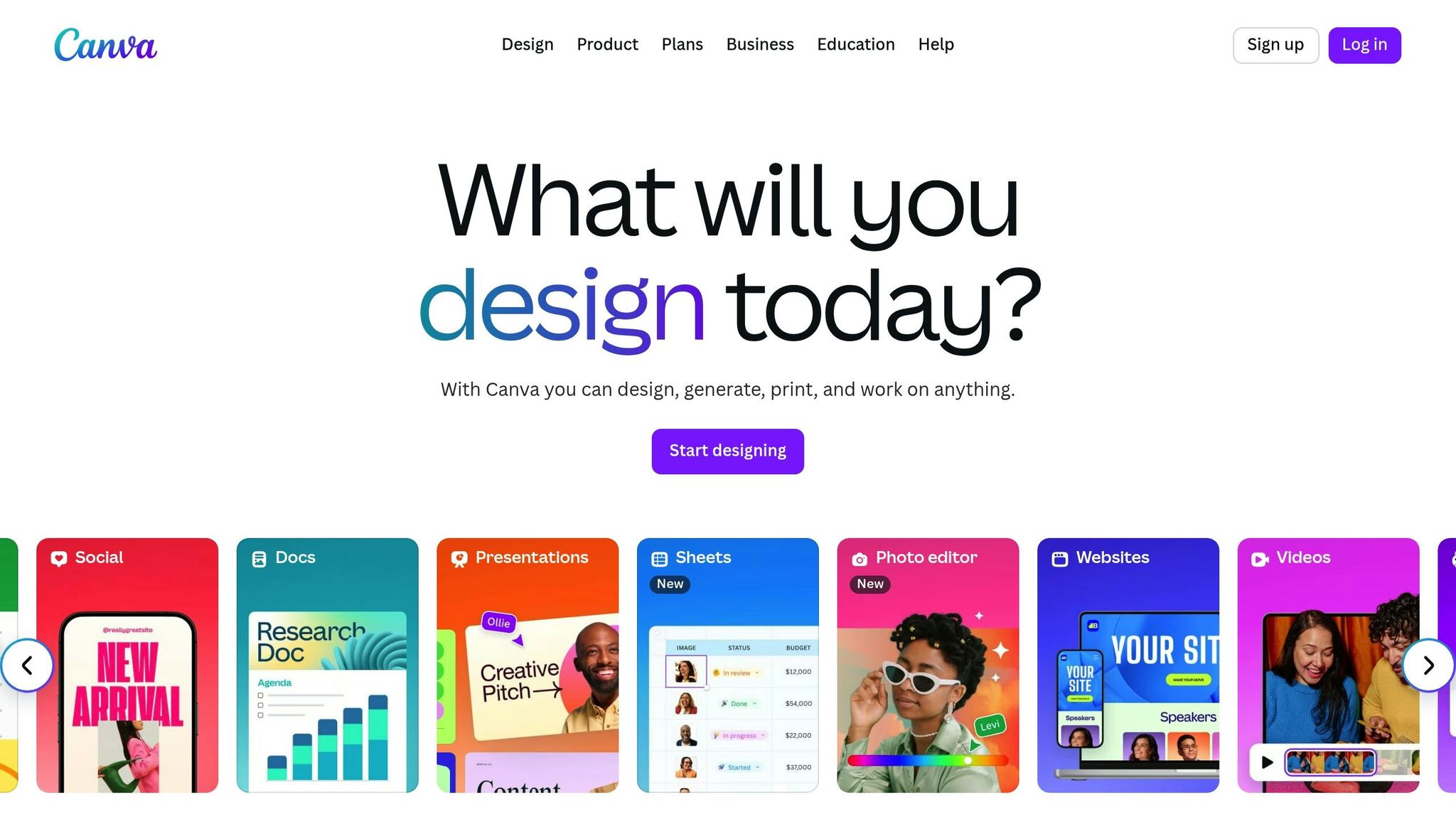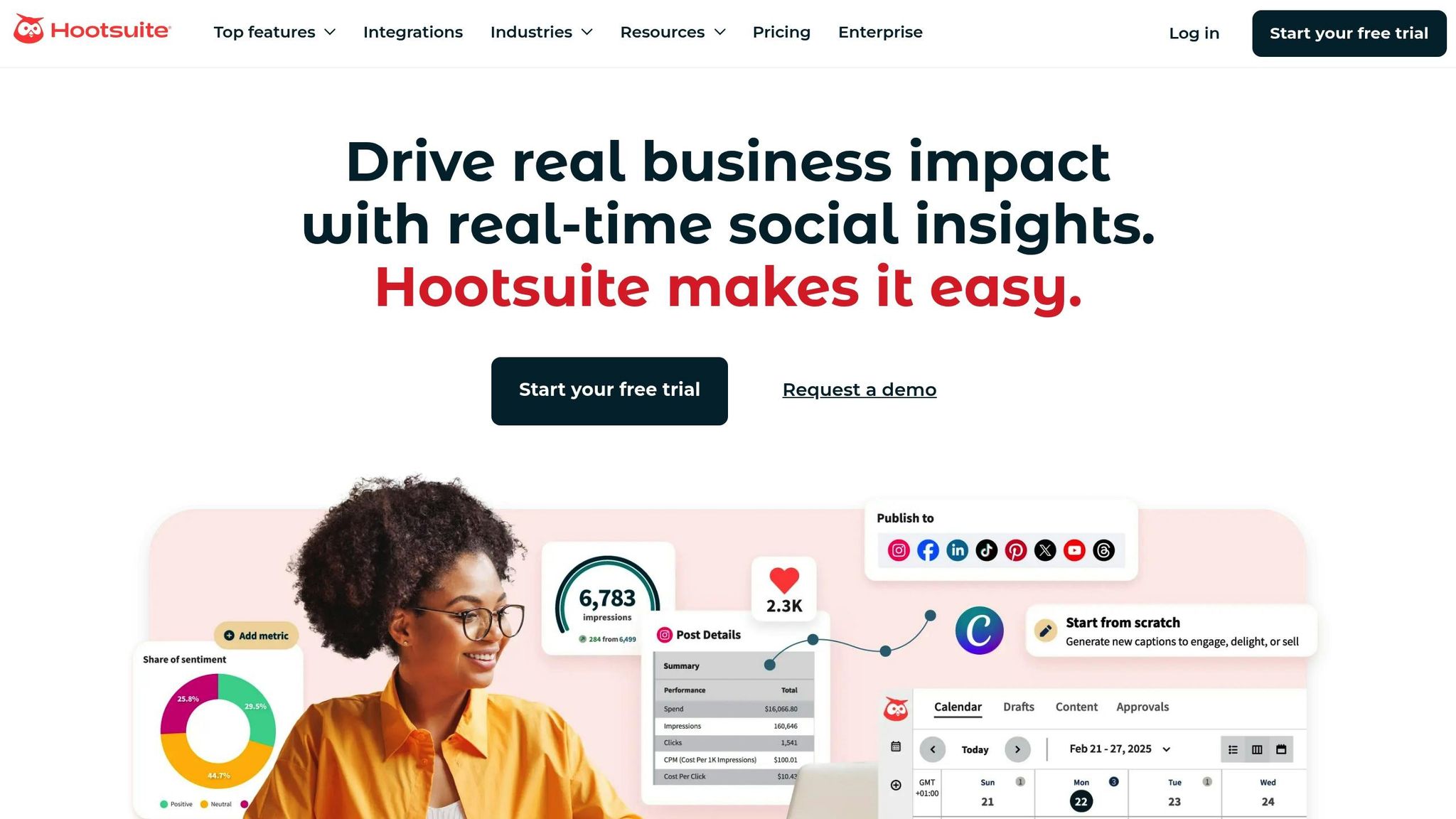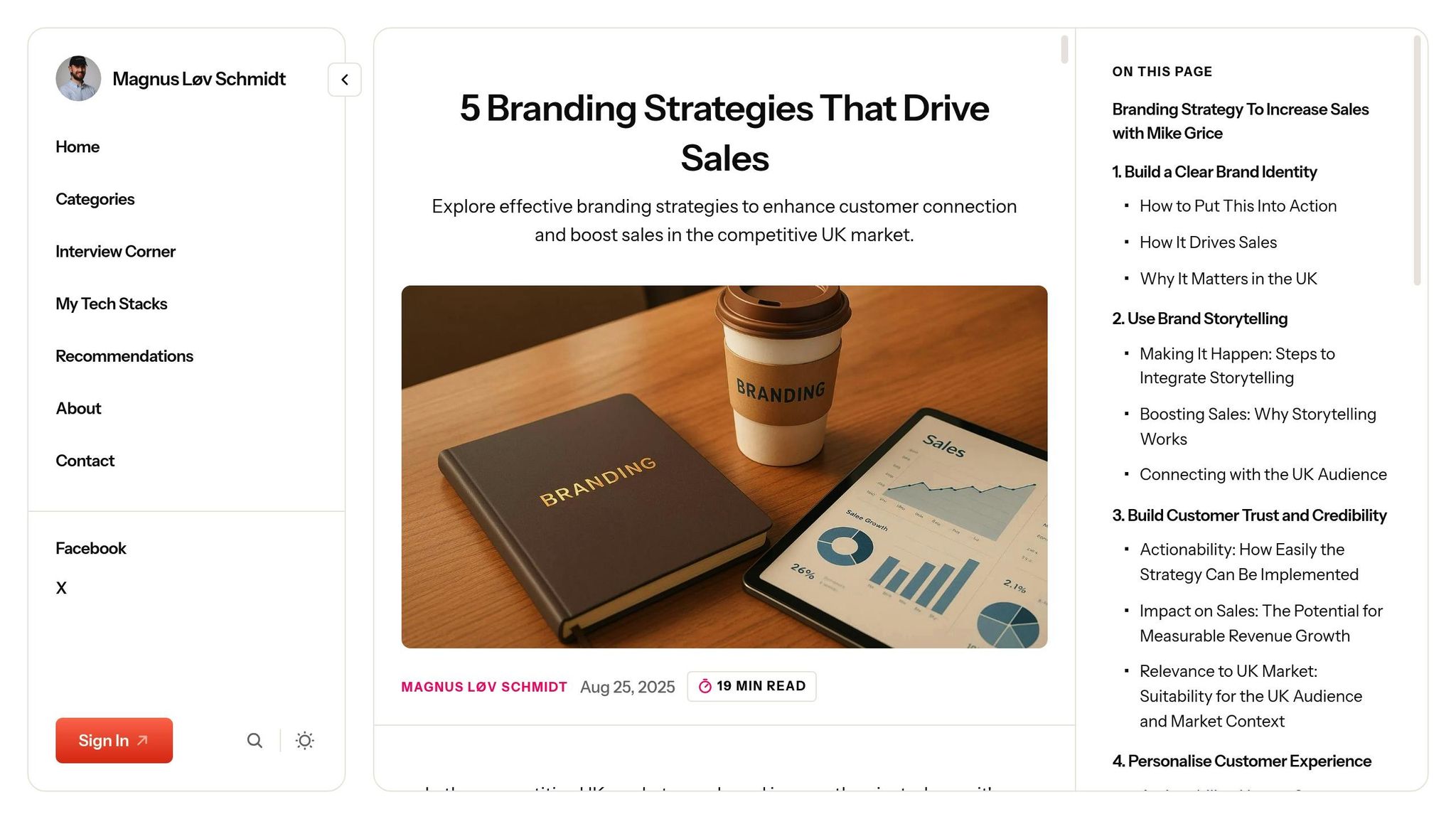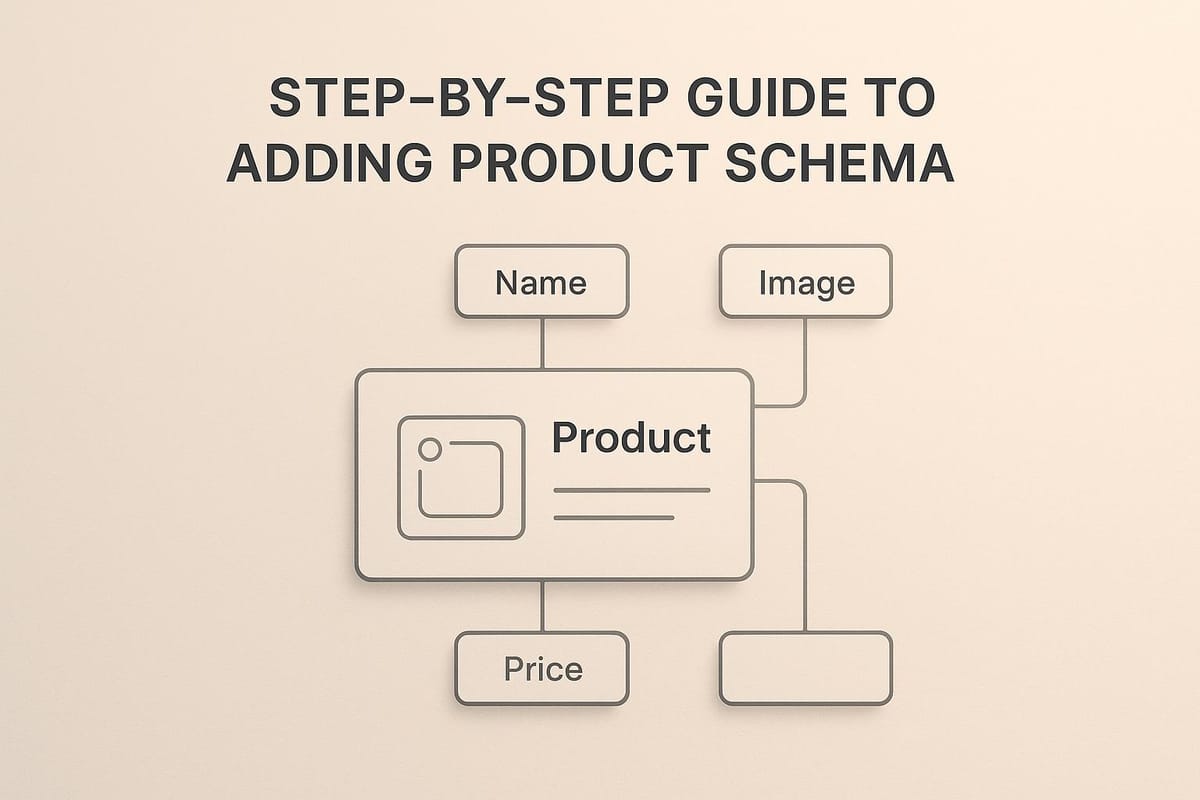Want your business to stand out online? A strong online brand is no longer optional - it's how customers find, trust, and choose you. Whether you're a local café or a growing tech startup, your brand needs to work across websites, social media, and beyond. Here's what matters most:
- Consistency is key: Your colours, fonts, and logo should look professional and cohesive across all platforms.
- Local relevance: Use British English, £ symbols, and UK-specific details like DD/MM/YYYY dates to connect with audiences.
- Social media focus: Choose platforms where your customers are active - Instagram for visuals, LinkedIn for B2B, or TikTok for younger users.
- Website essentials: Make it mobile-friendly, fast, and accessible while reflecting your brand identity.
- Tools to save time: Canva and Hootsuite can help you maintain a polished presence without overloading your team.
Your online brand shapes how people perceive your business - make it consistent, relevant, and easy to recognise. Keep reading for practical steps to boost your online presence.
Creating a Brand Identity in 2025 is Simple, Actually (FREE COURSE)
Creating a Consistent Visual Identity
Your visual identity is essentially your brand's first impression - it's what people recognise before they even see your name. Think of how instantly recognisable McDonald's golden arches are or how Coca-Cola's red and white branding stands out from a distance. This kind of recognition doesn’t happen by accident; it’s the result of thoughtful and consistent design.
To build a strong visual identity, you need a unified look that ties together your website, social media, and printed materials. Whether it’s your website header, Instagram posts, email signatures, or business cards, every piece should feel like it belongs to the same brand family.
However, many UK businesses struggle with maintaining this consistency across different platforms. For example, a logo that looks great on your website might become unreadable when shrunk down for a Twitter profile picture. Similarly, your chosen colours may appear differently on printed materials compared to digital screens, or even vary across devices.
Choosing Your Brand Colours, Fonts, and Logo
Colours play a big role in how people perceive your brand, thanks to colour psychology. Picking the right palette is more than just choosing what looks good - it’s about reflecting your brand’s personality.
Start with a primary colour that aligns with your brand’s message. For instance, blue often conveys trust and dependability (like Barclays or Tesco), while green suggests growth or sustainability. Red, on the other hand, creates urgency and energy, which is why brands like Virgin use it. Add two or three complementary colours that work well together across both digital and print formats.
Fonts are just as important. Choose a primary font for headlines and a secondary one for body text. Make sure they’re easy to read and work well on screens. Sans-serif fonts like Arial or Helvetica are ideal for digital platforms, while serif fonts can add a touch of sophistication to printed materials.
When designing your logo, versatility is key. Create different versions: a full-colour version, a black-and-white version, and a simplified icon. Your logo should look sharp whether it’s displayed as a tiny favicon at 16 pixels wide or blown up on a billboard.
Test your colour and font choices on different devices and backgrounds. What looks great on your laptop might not translate well to an Android phone or printed brochure. It’s worth taking the time to ensure your design works across all mediums.
Keeping Your Brand Consistent Across Platforms
Consistency doesn’t mean making everything identical - it’s about adapting your designs for different platforms while keeping your brand recognisable.
Start by creating a brand style guide. This document should include your exact colour codes (RGB for digital and CMYK for print), font specifications, logo usage rules, and spacing guidelines. It’s an essential tool for keeping your branding consistent, especially when working with freelancers or agencies.
Each social media platform has its own quirks and image requirements. For example, Facebook cover photos need to be 820 × 312 pixels, while Instagram posts work best as 1080 × 1080 squares. Instead of trying to force the same design into every format, create platform-specific templates that align with your brand’s colours, fonts, and overall aesthetic.
Don’t overlook smaller details like email signatures, letterheads, and digital documents. These should all follow the same visual rules, using your chosen colour palette and fonts. Even small touches - like ensuring the shade of blue in your email signature matches your website - can help reinforce your brand’s identity.
Think about how your branding appears in different contexts. Bright, bold colours might work well for Instagram Stories, while more muted tones could feel more appropriate for LinkedIn posts. The key is ensuring both styles still feel like they belong to the same brand.
Adapting Visual Identity for UK Audiences
When targeting UK audiences, it’s important to account for local preferences and expectations. Small details can make a big difference in building trust and creating a connection.
For instance, always display prices with the £ symbol and use the DD/MM/YYYY date format. These small adjustments show that you understand your audience and aren’t simply repurposing content from other markets.
Colour meanings can vary by region, so think about how your palette will resonate with UK consumers. Green, for example, is often associated with eco-friendliness and premium quality in the UK, while purple is linked to luxury and creativity.
Typography should also reflect British English spelling conventions. Use spellings like “colour” and “centre” in any text within your visual materials. This level of attention to detail demonstrates professionalism and an understanding of your market.
You can also tailor your branding to seasonal events or local traditions. For example, incorporating autumnal tones during October and November or nods to British holidays can make your brand feel more relevant and relatable.
Subtle references to British culture or design traditions can further strengthen your connection with UK customers. However, these should feel natural and not overdone - think tasteful rather than gimmicky.
Using Social Media Platforms for UK Audiences
Social media offers a dynamic way to connect with audiences in the UK. To make an impact, it’s essential to adapt your strategy to the unique characteristics of each platform.
Picking the Right Platforms for Your Audience
- Facebook: A favourite among UK users, Facebook is ideal for building communities and handling customer queries. Its support for longer posts makes it perfect for sharing company updates, behind-the-scenes content, and fostering meaningful interactions.
- Instagram: Popular with younger demographics, this platform is a must for brands that rely on visuals. High-quality images and short videos thrive here, especially when shared through features like Stories and Reels. It’s a great space to showcase products, company culture, and lifestyle content.
- LinkedIn: The go-to platform for B2B brands and professional services. LinkedIn is where business decisions are influenced and professional reputations are built. Use it to share industry insights, thought leadership, and professional milestones.
- X (formerly Twitter): Known for its fast pace, X acts as a digital town square in the UK. It’s perfect for sharing quick updates, breaking news, and displaying a distinct brand voice. Its immediacy makes it ideal for real-time engagement.
- TikTok: Hugely popular among younger audiences, TikTok is all about creative, authentic video content. Brands that can entertain and engage in a fun, relatable way will find a lot of potential here.
Rather than spreading your efforts thin across all platforms, focus on the two or three where your audience is most active. A concentrated and consistent presence often delivers better results than trying to be everywhere at once.
Timing Your Posts for UK Time Zones
When you post can be just as important as what you post. Aligning your schedule with your audience’s routines - like their morning commutes, lunch breaks, or evenings - can significantly boost engagement.
Different platforms have distinct patterns of activity. For instance, professional networks like LinkedIn tend to perform better during work hours, while platforms like Instagram and TikTok often see higher engagement in the evenings or on weekends. Seasonal changes also play a role, with longer summer days encouraging more outdoor activity and winter months driving more indoor screen time.
Test different posting times and monitor your analytics to refine your strategy. Regular adjustments based on this data will help you stay aligned with your audience’s habits, ensuring your content reaches them when they’re most active.
Using British English and Local References
Speaking your audience’s language - literally - helps build trust and connection. Use British spellings like colour, centre, and organise, and incorporate terms like mobile, queue, and biscuits to reflect everyday UK communication.
To deepen engagement, weave in references to UK-specific events and traditions. Whether it’s mentioning the Chelsea Flower Show, Bonfire Night, or local bank holidays, these nods to UK life make your content feel timely and relatable. Remember, the UK is diverse, so aim to be inclusive and mindful of regional differences when crafting your messaging.
Making Your Website Match Your Brand
Your website is more than just a collection of pages - it's your digital storefront. It should mirror your brand identity while meeting the needs of UK audiences. A cohesive website design builds trust and keeps visitors engaged.
Adding Visual Branding to Website Design
Your website's design should reflect your brand's personality. Use your primary colours for key elements like headers, buttons, and navigation, while secondary colours can complement backgrounds and accents. This approach helps create a natural flow, guiding users through your content.
Choose web-safe fonts that align with your brand. For a modern vibe, go with sans-serif fonts; for something more classic, serif fonts are a better fit. Make sure these fonts load quickly on all devices to avoid delays.
Place your logo prominently in the top-left corner as a clickable link to your homepage. Have variations of your logo ready - such as full-colour, simplified, or monochrome versions - for different contexts.
Consistency in imagery also matters. Whether you use photos, illustrations, or graphics, stick to a single aesthetic that supports your brand values. For instance, playful and creative brands might opt for vibrant colours and dynamic layouts, while professional services often benefit from clean, minimalist designs.
Once your visuals are aligned, focus on tailoring your content and layout for UK audiences.
Customising Content and User Experience for the UK
UK users have specific preferences, so localising your site is key to building trust. For example:
- Display prices with the £ symbol.
- Use DD/MM/YYYY for dates (e.g., 15/03/2024).
- Stick to UK measurement units like miles and litres.
- Use British spellings and terms - mobile phone instead of cell phone, postcode instead of zip code, and biscuits (unless you’re referring to the baked treat).
Also, follow UK conventions for addresses and phone numbers, such as +44 (0)20 7946 0958. These details might seem small, but they make a big difference in creating a trustworthy and relatable experience.
Making Your Website Mobile-Friendly and Accessible
Considering the majority of UK users browse on mobile devices, your site must be optimised for quick load times - under three seconds is ideal. Compress images to maintain quality while reducing file sizes, and use modern formats like WebP for better results.
Design for touch navigation by ensuring buttons and interactive elements are at least 44 pixels square, with enough space between them to avoid accidental clicks. Test how your brand colours appear on mobile screens, especially in bright outdoor conditions, to ensure readability.
Accessibility is just as important. In the UK, public sector websites are legally required to meet WCAG 2.1 AA standards, but private businesses can also benefit by showing a commitment to inclusivity. To meet these standards:
- Ensure strong colour contrast between text and backgrounds (at least a 4.5:1 ratio for normal text).
- Add alternative text to images to describe their purpose. For purely decorative images, mark them as such instead of leaving the alt text blank.
- Support keyboard navigation so users can access all features without a mouse. Test this by navigating your site using the Tab key.
- Allow text resizing up to 200% without breaking your layout. This helps users with visual impairments while maintaining your brand's design.
Using Branding Tools to Save Time
Building a consistent brand across various platforms can feel like a juggling act. Fortunately, the right tools can simplify your workflow, helping you maintain brand consistency without eating up all your time. Here's a closer look at how tools like Canva, Hootsuite, and Magnusloev.com can make branding easier.
Creating Branded Graphics with Canva

Canva is a game-changer for businesses that don’t have a dedicated design team. It offers an extensive library of templates tailored to UK social media and print standards, eliminating the guesswork when it comes to sizing.
Start by setting up a brand kit. Upload your logo variations, input your brand colours using hex codes, and select your preferred fonts. Once done, these elements will be integrated into all your designs. For content specific to the UK, Canva even provides templates that reflect local preferences.
One standout feature is Magic Resize, which lets you adapt a single design for multiple platforms in seconds. For instance, you can create an Instagram post and instantly resize it for LinkedIn, Facebook, or Twitter - all while maintaining a polished, cohesive look.
Canva’s stock photo library is another highlight, offering images that resonate with UK audiences. Instead of generic office photos, you can choose visuals like London’s skyline, lively high streets, or diverse groups of people in recognisably British settings.
Collaboration is also made easy. Shared folders allow your team to access approved templates and brand assets, ensuring everyone works within the same guidelines and keeps the branding consistent.
Managing Social Media with Hootsuite

Design is just one piece of the puzzle. Tools like Hootsuite can help you take control of your social media presence, ensuring your branding efforts extend across platforms.
Hootsuite’s scheduling feature is particularly useful for posting at optimal UK times, such as 09:00–10:00 and 19:00–21:00 GMT. With bulk scheduling, you can plan weeks of content in advance by uploading a CSV file containing your posts, times, and platforms. This keeps your posting schedule consistent and frees up time for other tasks.
Social listening tools within Hootsuite allow you to monitor mentions of your brand across UK platforms. By tracking your brand name, hashtags, and other key terms, you can quickly respond to customer feedback or nip potential issues in the bud.
The analytics dashboard offers insights tailored to UK businesses. You can identify what content performs best with local audiences, monitor engagement during working hours, and spot trending topics to refine your strategy.
Hootsuite also helps maintain a unified brand voice with its team collaboration features. Approval workflows ensure posts are reviewed before they go live, and saved replies make it easier to handle common customer queries efficiently.
Using Magnusloev.com's Branding Resources

If you’re looking to build or refine your branding strategy, Magnusloev.com is a treasure trove of resources designed specifically for the UK market. It offers step-by-step guides and practical insights to help businesses tackle branding challenges with confidence.
The platform covers a wide range of topics, from developing a visual identity to managing digital marketing campaigns. Whether you’re working on SEO, recovering from Google penalties, or building an ecommerce brand, the categorised content makes it easy to find what you need.
Magnusloev.com also keeps you informed with weekly newsletters featuring the latest trends in branding and digital marketing. These updates include curated insights and special offers, helping you stay ahead in a constantly evolving landscape.
What’s more, the site offers practical tutorials that break down complex branding strategies into actionable steps. This makes it easier to apply what you’ve learned and see real results.
Best of all, everything on Magnusloev.com is free to access, making it a budget-friendly resource for businesses at any stage of their branding journey.
Tracking and Maintaining Your Online Brand
Building a brand isn’t a one-and-done process - it’s an ongoing effort. To keep your online presence strong, you need to monitor how your brand is performing and make updates as your business and market evolve. Without consistent tracking and maintenance, even the most recognisable brand can lose its edge over time.
Monitoring Brand Performance with Analytics
Google Analytics is one of the best tools for checking how your brand is performing online. If you set your account to the UK locale, you’ll get data that reflects local user behaviour and time zones accurately.
Pay attention to brand-specific metrics, especially direct traffic - this is when people type your brand name directly into their browser. It’s a clear indicator of brand recognition. You can also use Google Search Console to track branded search terms, which shows how often people search for your company name compared to general industry terms.
Dig into engagement metrics like time spent on site, pages per session, and bounce rates. These numbers can reveal how well your content is resonating with visitors. For example, if users from social media are spending less time on your site than those coming from organic search, it might mean your social media messaging doesn’t match your website’s content.
Another key area to monitor is conversion paths. A customer might first discover your brand on Instagram, search for you on Google, and then make a purchase after reading your blog. Understanding these multi-step journeys can show which parts of your strategy work well together.
Set up custom alerts for big shifts in metrics like direct traffic or branded searches. A sudden drop could signal a reputation issue, while a spike might indicate a campaign that’s performing better than expected - either way, these changes deserve your attention.
These insights are the foundation for regular reviews that keep your strategy on track.
Running Regular Brand Reviews
Once you’ve analysed your performance data, take time to review your brand’s overall alignment with your strategy. Quarterly audits can help you catch inconsistencies before they confuse your audience. Start by checking all digital touchpoints - your website, social media profiles, email signatures, and any third-party listings. Look for outdated logos, mismatched colours, or messaging that no longer fits your brand’s current direction.
Visual consistency is critical. Check that profile photos, cover images, and other visuals follow your style guide. Even small inconsistencies can make your brand seem unprofessional or disjointed.
Content audits are equally important. Review your blog posts, social media captions, and website copy to ensure your brand voice remains consistent. Use British spellings and currency formats to maintain local relevance, and double-check that your tone aligns with industry expectations.
Keep your content fresh and relevant. Events or references that worked last year might feel out of touch now. Your brand should reflect what’s happening in the UK market without chasing every passing trend.
Finally, compare your brand’s position against current market trends. This isn’t about copying others - it’s about ensuring your brand stays distinct while remaining relevant.
Regular reviews like these help your brand adapt to changes in the market and remain consistent over time.
Staying Current with UK Market Changes
The digital landscape in the UK is always shifting, and your brand needs to keep up. For instance, mobile usage now dominates web traffic, so your brand must perform well across all devices.
Social media trends also influence how brands connect with their audiences. When Instagram launched Reels, many brands adjusted their content strategies to engage users through short-form videos. Similarly, LinkedIn’s focus on video content has pushed B2B brands to adopt more dynamic and professional approaches.
Regulations can also impact your brand. GDPR compliance, for example, has reshaped how brands handle data collection, while accessibility laws now require visual branding to be more inclusive for users with disabilities. Staying informed about these changes ensures your brand messaging stays compliant and inclusive.
Economic changes might call for adjustments in tone. During challenging times, brands often shift to more empathetic and value-driven messaging. Keeping an eye on UK economic indicators and consumer sentiment can help you strike the right balance.
Cultural moments provide opportunities to connect with your audience. Whether it’s supporting local initiatives, acknowledging national events, or taking part in positive social movements, your brand should reflect the values of your UK audience.
To stay ahead, keep a brand evolution calendar. Use it to schedule regular reviews and plan major updates during quieter periods. Align content updates with seasonal trends or key industry events. This approach ensures your brand feels proactive, not reactive.
Building a Brand That Stands Out in the UK
To create a brand that resonates with UK audiences, it’s essential to go beyond consistent visuals and effective online engagement. Success lies in understanding and incorporating local culture into your strategy.
In the UK’s diverse market, connecting with your audience means blending thoughtful design, clear messaging, and a genuine grasp of local preferences. British consumers are drawn to brands that reflect their values, communicate in British English, and incorporate familiar humour and cultural references. These touches make your brand feel relatable and trustworthy.
Consistency is key - ensure your visual identity is cohesive across your website, social media, and customer communications. Tools like Canva and Hootsuite can help you maintain this consistency while tailoring your content to the UK market. However, it’s important to strike a balance: adapt to local nuances without losing the essence of what makes your brand unique.
FAQs
How can I keep my brand's visual identity consistent across online and printed materials?
To keep your visual identity consistent across both digital platforms and printed materials, it's essential to create detailed brand guidelines. These should cover the fundamentals: your logo, colour palette, typography, and preferred image style. By setting these standards, you ensure your brand looks uniform and professional in every context.
Make it a habit to regularly review your materials to confirm they adhere to these guidelines. This not only strengthens your brand's overall image but also makes it easier for your audience to recognise and trust you. Using tools like templates can further streamline the process, helping maintain uniformity across different formats.
How can I adapt my online branding to connect with UK audiences?
To truly connect with audiences in the UK, it's essential to focus on genuine connections and local relevance. Use a touch of British humour, maintain a tone that's informal yet professional, and weave in references to familiar traditions or events. These elements help create a brand voice that feels relatable and in tune with UK sensibilities. Emphasising community values and celebrating heritage can also strike a chord with UK consumers.
To engage effectively, consider creating content tailored to specific locations and using hashtags that resonate with local audiences. Partnering with UK-based influencers can also boost credibility and make your brand more approachable. Pay close attention to details like spelling, date formats, and even colour choices across your website, social media, and visuals. These small but important touches show that you understand and respect UK preferences, which can go a long way in building trust.
How can Canva and Hootsuite help my team maintain a consistent online brand without adding extra stress?
Canva and Hootsuite make it easier to maintain a consistent online presence by offering tools that streamline content creation and management. With Canva's Brand Kit, you can ensure that every design sticks to your brand's pre-set colours, fonts, and assets. This means fewer inconsistencies and quicker, more professional-looking visuals that stay true to your identity.
Hootsuite takes things further by letting your team schedule, manage, and collaborate on posts across various platforms. Plus, its integration with Canva enables smooth content sharing and approval processes, keeping everyone aligned. Together, these tools help your team work efficiently and stay organised - without the stress.




Comments